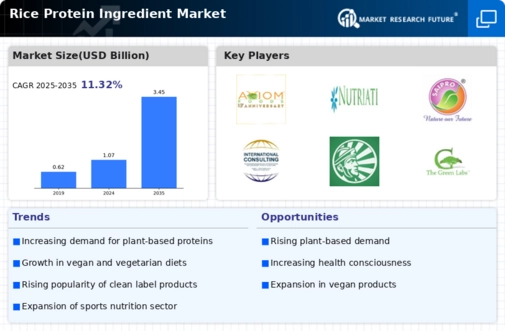Innovations in Food Technology
The Rice Protein Ingredient Market is witnessing advancements in food technology that enhance the extraction and application of rice protein. Innovations in processing techniques, such as enzymatic hydrolysis and membrane filtration, are improving the yield and quality of rice protein, making it more appealing to manufacturers. These technological developments are likely to drive market growth, as they enable the incorporation of rice protein into a wider array of food products, from dairy alternatives to baked goods. As the food industry continues to evolve, the ability to produce high-quality rice protein ingredients efficiently will be a key factor in meeting consumer demand.
Increasing Health Consciousness
The Rice Protein Ingredient Market is experiencing a notable surge in demand driven by a growing awareness of health and wellness among consumers. As individuals increasingly prioritize nutritious diets, the appeal of rice protein, known for its hypoallergenic properties and rich amino acid profile, becomes more pronounced. This trend is reflected in market data, indicating that the plant-based protein segment is projected to grow at a compound annual growth rate of approximately 8% over the next five years. Consumers are gravitating towards rice protein as a viable alternative to animal-based proteins, which aligns with their health goals. Consequently, manufacturers are expanding their product lines to include rice protein ingredients, catering to this health-conscious demographic.
Rising Popularity of Sports Nutrition
The Rice Protein Ingredient Market is benefiting from the escalating interest in sports nutrition and fitness. As athletes and fitness enthusiasts seek high-quality protein sources to support their training regimens, rice protein emerges as a favorable option due to its digestibility and amino acid profile. Recent data indicates that the sports nutrition market is projected to grow at a CAGR of 10% through 2026, with rice protein ingredients increasingly featured in protein powders and supplements. This trend not only highlights the versatility of rice protein but also underscores its potential to cater to a diverse consumer base, including those with dietary restrictions.
Expansion of Vegan and Vegetarian Diets
The Rice Protein Ingredient Market is significantly influenced by the rising adoption of vegan and vegetarian diets. As more individuals choose plant-based lifestyles for ethical, environmental, or health reasons, the demand for rice protein ingredients is likely to increase. Market analysis suggests that the plant-based food sector is expected to reach a valuation of over 74 billion dollars by 2027, with rice protein playing a crucial role in this growth. This shift in dietary preferences is prompting food manufacturers to innovate and incorporate rice protein into various products, from protein bars to meat alternatives, thereby enhancing the market's potential.
Sustainability and Environmental Concerns
The Rice Protein Ingredient Market is increasingly shaped by sustainability and environmental considerations. As consumers become more aware of the ecological impact of their food choices, the demand for sustainable protein sources rises. Rice protein, derived from a crop that requires less water and land compared to animal farming, presents an attractive alternative. Market trends indicate that sustainable food products are gaining traction, with a projected increase in sales of plant-based proteins. This shift towards environmentally friendly options is likely to bolster the rice protein market, as consumers seek products that align with their values regarding sustainability.


















Leave a Comment